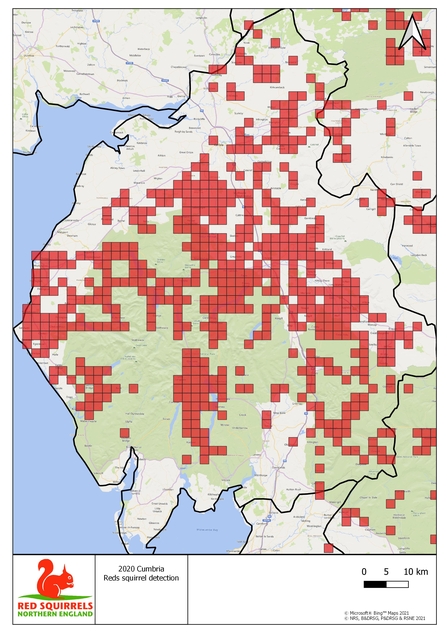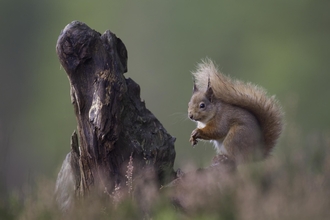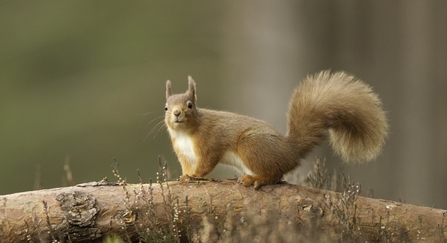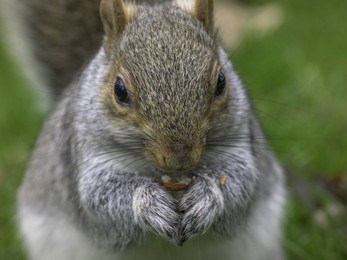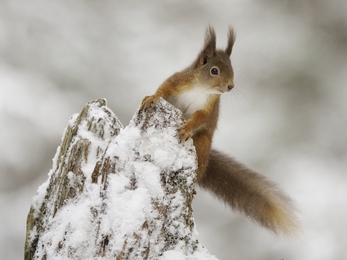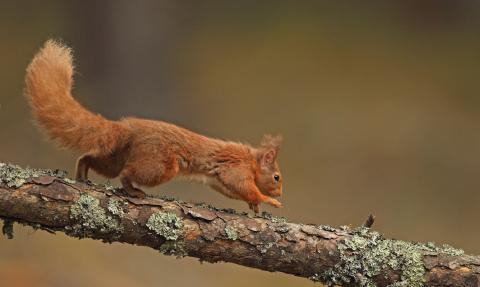
Red squirrel © Luke Massey/2020VISION
Red squirrel conservation
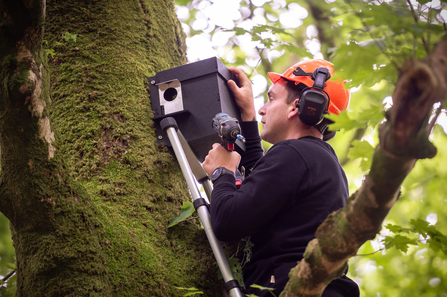
Josh Adams putting up red squirrel nest box with The Cumberland © Harry Atkinson Photography
In our area
Providing nests for these endangered animals is just part of the work being done by our red squirrel ranger Joshua Adams, thanks to Cumberland Building Society and Lakeland Limited. Read more
What is the main threat to the UK's native Red squirrel population?
Squirrel pox has decimated red squirrels
The non-native grey squirrel was introduced to England in the late 1870s from America and is the primary cause of decline of the red squirrel. Red squirrels have been found in England since the end of the last Ice Age and are part of our native fauna.
It does so by out-competing red squirrels for food in deciduous and mixed woodlands and by transmitting a disease ‘squirrelpox’, the squirrel Parapoxvirus, which is lethal to red squirrels.
Surveys show conservation work by volunteers has kept red squirrel numbers stable across the north of England since 2012. Saving our native red squirrel is relentless and long term, can you help? Please click here to join others who are already supporting our work for Cumbria's wildlife & wildplaces including our red squirrel conservation work
You can help red squirrels by reporting your squirrel sightings
The squirrel sightings Survey123 app will detect the location for you automatically and you'll have a historical record/map of all your sightings collected,
Report a grey squirrel sighting The non-native grey squirrel was introduced to England in the late 1870s from America and is the primary cause of decline of the red squirrel.
It does so by out-competing red squirrels for food in deciduous and mixed woodlands and by transmitting a disease ‘squirrelpox’, the squirrel Parapoxvirus, which is lethal to red squirrels.
Report my red squirrel sighting If you see a native red squirrel, please report your sighting to Red Squirrels Northern England. Your sighting is very valuable in monitoring their locations.
Why do red squirrels matter?
The plight of the red squirrel is recognised in local, regional, national and international conservation policies. It is afforded the highest level of protection under UK law: the Wildlife and Countryside Act.
Made eternally popular through Beatrix Potter character Squirrel Nutkin, children and adults across the UK are familiar with the cheeky nature of the animals.
Sadly, red squirrels have suffered severe population decline across the UK. Here in northern England though, evidence is starting to suggest that, through the commitment and dedication of conservation groups, red squirrel range is being maintained.
By working together we can ensure that one of our most-loved iconic species is known to future generations.
Volunteer with your local red squirrel group in Cumbria
I want to volunteer with my local red squirrel group Cumbria has 14 red squirrel groups covering most of the county – these are made up entirely of volunteers. The groups are dedicated to conserving Cumbria’s red squirrels and work closely with Red Squirrels Northern England - without their support, conserving Cumbria’s red squirrels would not be possible.
Contact your nearest red squirrel group to find out how you can help them protect the red squirrels in your area. There are many ways to make a difference, including practical conservation work, fundraising, events and much more. Each group is independent and will have its own requirements for the volunteer help it needs.
Map of Red squirrel local voluntary groups in Cumbria
Looking for red squirrels in Cumbria
If you're walking in woodlands in Cumbria keep your eyes peeled for both red and grey squirrels
It’s quite easy to tell them apart – but don't rely on the coat colour. The reds are considerably smaller and often have long tufts to their ears. Greys always have small, rounded ears and have white hairs along the edge of the tail, giving the tail a halo.
Here's where you're likely to spot a red squirrel
Argill Woods Nature Reserve, near Brough
This steep-sided wooded valley with waterfalls and pools is an undisturbed wild place. Red squirrels have recolonised the area, and are thriving following a successful programme of grey squirrel removal.
Augill Pasture Nature Reserve, near Brough
Around the remains of old lead smelt mills, species rich grasslands contain a huge variety of different meadow flowers such as orchids, melancholy thistle and devil's-bit scabious.
Bowber Head Farm Nature Reserve
This traditional small-holding is home to one of the rarest and most threatened wildlife habitats in Cumbria: northern upland hay meadows. There is a red squirrel cam streaming at this reserve.
Clints Quarry Nature Reserve, near Egremont
A fascinating place not only for wildlife but also for geology and industrial archaeology.
Quarry Banks Nature Reserve, near Cumwhinton
Quarry Banks Allan Wilson Memorial Reserve is a peaceful nature reserve and in spring the woodland is carpeted with flowers and the air is full of bird song.
Smardale Nature Reserve, near Kirkby Stephen
Stunning scenery surrounds the steep wooded slopes of Smardale Gill. Red squirrels can be seen racing between the trees. Only 10 years ago, reds were almost extinct here following an influx of greys. Thankfully reds are now once again thriving.
Wreay Woods Nature Reserve, near Carlisle
Wreay Woods is a diverse woodland that follows the course of the River Petteril.
